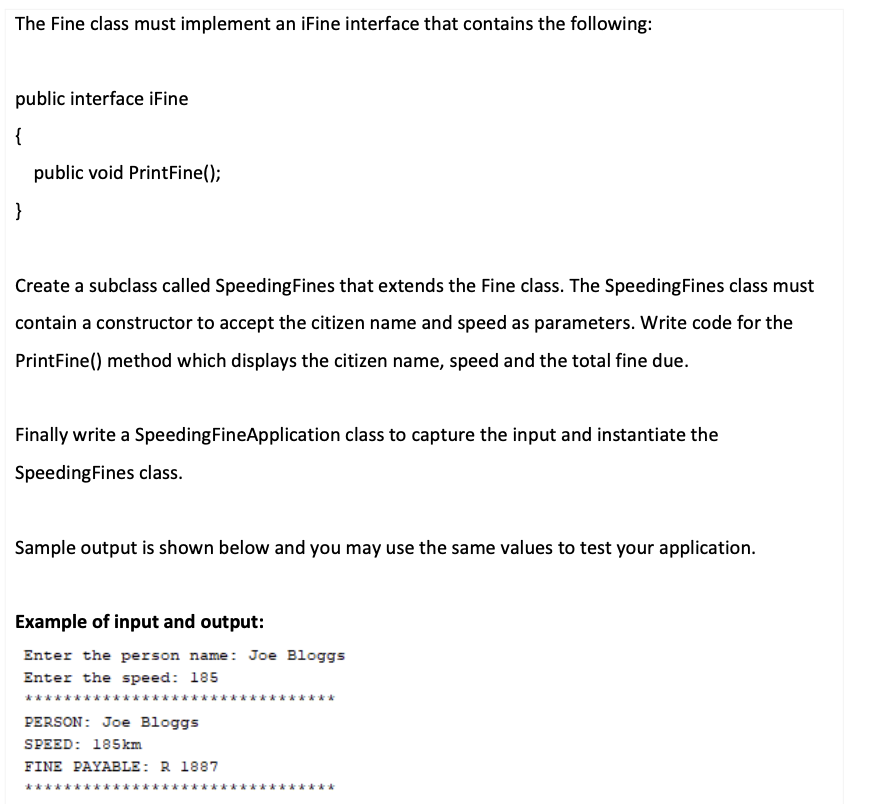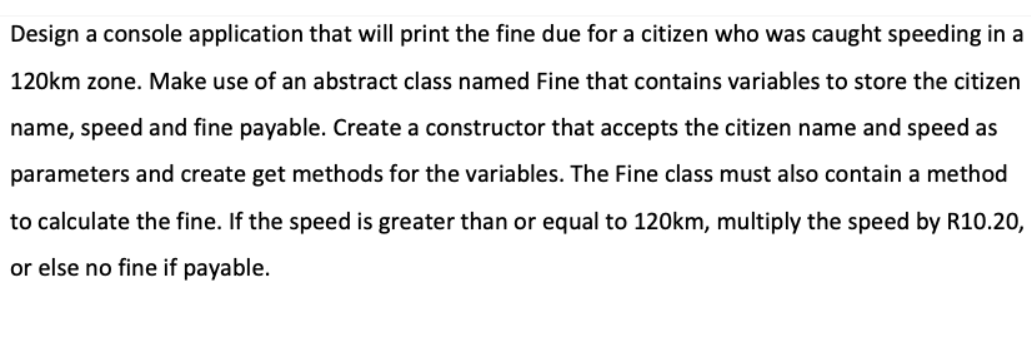The Fine class must implement an iFine interface that contains the following: public interface iFine { public void PrintFine(); } Create a subclass called SpeedingFines that extends the Fine class. The SpeedingFines class must contain a constructor to accept the citizen name and speed as parameters. Write code for the PrintFine() method which displays the citizen name, speed and the total fine due. Finally write a SpeedingFineApplication class to capture the input and instantiate the SpeedingFines class. Sample output is shown below and you may use the same values to test your application. Example of input and output: Enter the person name: Joe Bloggs Enter the speed: 185 ******* PERSON: Joe Bloggs SPEED: 185km FINE PAYABLE: R 1887 *** ***** Design a console application that will print the fine due for a citizen who was caught speeding in a 120km zone. Make use of an abstract class named Fine that contains variables to store the citizen name, speed and fine payable. Create a constructor that accepts the citizen name and speed as parameters and create get methods for the variables. The Fine class must also contain a method to calculate the fine. If the speed is greater than or equal to 120km, multiply the speed by R10.20, or else no fine if payable.
The Fine class must implement an iFine interface that contains the following: public interface iFine { public void PrintFine(); } Create a subclass called SpeedingFines that extends the Fine class. The SpeedingFines class must contain a constructor to accept the citizen name and speed as parameters. Write code for the PrintFine() method which displays the citizen name, speed and the total fine due. Finally write a SpeedingFineApplication class to capture the input and instantiate the SpeedingFines class. Sample output is shown below and you may use the same values to test your application. Example of input and output: Enter the person name: Joe Bloggs Enter the speed: 185 ******* PERSON: Joe Bloggs SPEED: 185km FINE PAYABLE: R 1887 *** ***** Design a console application that will print the fine due for a citizen who was caught speeding in a 120km zone. Make use of an abstract class named Fine that contains variables to store the citizen name, speed and fine payable. Create a constructor that accepts the citizen name and speed as parameters and create get methods for the variables. The Fine class must also contain a method to calculate the fine. If the speed is greater than or equal to 120km, multiply the speed by R10.20, or else no fine if payable.
Computer Networking: A Top-Down Approach (7th Edition)
7th Edition
ISBN:9780133594140
Author:James Kurose, Keith Ross
Publisher:James Kurose, Keith Ross
Chapter1: Computer Networks And The Internet
Section: Chapter Questions
Problem R1RQ: What is the difference between a host and an end system? List several different types of end...
Related questions
Question

Transcribed Image Text:The Fine class must implement an iFine interface that contains the following:
public interface iFine
{
public void PrintFine();
}
Create a subclass called SpeedingFines that extends the Fine class. The SpeedingFines class must
contain a constructor to accept the citizen name and speed as parameters. Write code for the
PrintFine() method which displays the citizen name, speed and the total fine due.
Finally write a SpeedingFineApplication class to capture the input and instantiate the
SpeedingFines class.
Sample output is shown below and you may use the same values to test your application.
Example of input and output:
Enter the person name: Joe Bloggs
Enter the speed: 185
*******
PERSON: Joe Bloggs
SPEED: 185km
FINE PAYABLE: R 1887
***
*****

Transcribed Image Text:Design a console application that will print the fine due for a citizen who was caught speeding in a
120km zone. Make use of an abstract class named Fine that contains variables to store the citizen
name, speed and fine payable. Create a constructor that accepts the citizen name and speed as
parameters and create get methods for the variables. The Fine class must also contain a method
to calculate the fine. If the speed is greater than or equal to 120km, multiply the speed by R10.20,
or else no fine if payable.
Expert Solution
This question has been solved!
Explore an expertly crafted, step-by-step solution for a thorough understanding of key concepts.
Step by step
Solved in 4 steps with 1 images

Recommended textbooks for you

Computer Networking: A Top-Down Approach (7th Edi…
Computer Engineering
ISBN:
9780133594140
Author:
James Kurose, Keith Ross
Publisher:
PEARSON

Computer Organization and Design MIPS Edition, Fi…
Computer Engineering
ISBN:
9780124077263
Author:
David A. Patterson, John L. Hennessy
Publisher:
Elsevier Science

Network+ Guide to Networks (MindTap Course List)
Computer Engineering
ISBN:
9781337569330
Author:
Jill West, Tamara Dean, Jean Andrews
Publisher:
Cengage Learning

Computer Networking: A Top-Down Approach (7th Edi…
Computer Engineering
ISBN:
9780133594140
Author:
James Kurose, Keith Ross
Publisher:
PEARSON

Computer Organization and Design MIPS Edition, Fi…
Computer Engineering
ISBN:
9780124077263
Author:
David A. Patterson, John L. Hennessy
Publisher:
Elsevier Science

Network+ Guide to Networks (MindTap Course List)
Computer Engineering
ISBN:
9781337569330
Author:
Jill West, Tamara Dean, Jean Andrews
Publisher:
Cengage Learning

Concepts of Database Management
Computer Engineering
ISBN:
9781337093422
Author:
Joy L. Starks, Philip J. Pratt, Mary Z. Last
Publisher:
Cengage Learning

Prelude to Programming
Computer Engineering
ISBN:
9780133750423
Author:
VENIT, Stewart
Publisher:
Pearson Education

Sc Business Data Communications and Networking, T…
Computer Engineering
ISBN:
9781119368830
Author:
FITZGERALD
Publisher:
WILEY